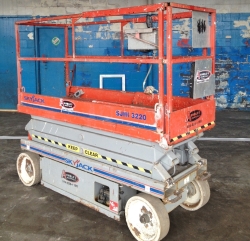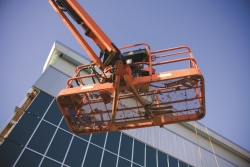The requirements around the familiarization of aerial lift operators listed in applicable ANSI and CSA standards are very clear but often overlooked, misunderstood or ignored. This is unfortunate, as allowing operators to use aerial lifts with which they are unfamiliar is a practice that can lead to tragic results.
 Part of the problem stems from a lack of knowledge. Owners, users and/or operators of aerial lifts are often simply unaware of what is required of them with respect to the safe use and operation of the equipment. Let’s turn ignorance into enlightenment by taking a step by step approach at exactly what’s required. In the interest of brevity, we will focus on the requirements relative to aerial boomlifts and scissor lifts.
Part of the problem stems from a lack of knowledge. Owners, users and/or operators of aerial lifts are often simply unaware of what is required of them with respect to the safe use and operation of the equipment. Let’s turn ignorance into enlightenment by taking a step by step approach at exactly what’s required. In the interest of brevity, we will focus on the requirements relative to aerial boomlifts and scissor lifts.
The usual place to start when searching for safety rules is with regionally mandated occupational safety and health (OSH) regulations. However, when it comes to the topic of familiarizing aerial lift operators, there really are no specific regulatory requirements that address it.
That being said, many OSH regulations reference at least two other sources where much more detailed information may be found, including industry standards and the instructions of the manufacturer.
Throughout the United States and most of Canada, the most widely referenced and accepted standards relative to the design, construction and use of aerial lifts are the ANSI (American National Standards Institute) A92 series of standards. The specific standards as they relate to booms and scissors (respectively) are named as follows:
- ANSI/SIA A92.5 – Boom-supported Elevating Work Platforms (Aerial Boomlifts)
- ANSI/SIA A92.6 – Self-propelled Elevating Work Platforms (Scissor Lifts)
Before we investigate what these two standards contain about the familiarization of operators, we have to consider that familiarization follows general training. That means that before aerial lift operators are eligible to receive familiarization, they must have already received general training. General training should cover topics such as but not limited to:
- The purpose and use of manuals
- That operating manuals are an integral part of the aerial platform and must be stored properly in the weather-resistant compartment when not in use
- 3. A pre-start inspection
- Responsibilities associated with problems or malfunctions affecting the operation of the aerial platform
- Factors affecting stability
- The purpose of placards and decals
- Workplace inspection
- Safety rules and regulations
- Authorization to operate
- Operator warnings and instructions
- Actual operation of the aerial platform under the direction of a qualified person. The trainee shall operate the aerial platform for a sufficient period of time to demonstrate proficiency in the actual operation of the aerial platform.
As you can see, general training covers information considered to be fundamental to all makes and models of boom and scissor lifts. However, ANSI and CSA requirements also call for operators to be familiarized with the actual aerial lift they are assigned to operate. The content of familiarization breaks down as follows:
- The location of the weather resistant compartment (for manual(s) storage)
- The purpose and function of all controls
- Safety devices and operating characteristics specific to the aerial platform.
Although these items appear very nondescript, consider for a moment the amount of detail that could be entailed in covering items 2 and 3 in the following scenario.
 An operator receives general and specific training on an electric-powered, slab-type unit with an articulated boom capable of 45 feet of platform height. The operator uses the unit to paint the interior walls of a structure that is under construction. When the job is completed, the operator is then assigned to paint the exterior walls using an engine powered, rough terrain (RT) unit with a telescopic boom capable of 120 feet of platform height. The general training this operator has already received covers the basic operation of both units. However, some specific items that would need to be covered during familiarization of the RT unit might be:
An operator receives general and specific training on an electric-powered, slab-type unit with an articulated boom capable of 45 feet of platform height. The operator uses the unit to paint the interior walls of a structure that is under construction. When the job is completed, the operator is then assigned to paint the exterior walls using an engine powered, rough terrain (RT) unit with a telescopic boom capable of 120 feet of platform height. The general training this operator has already received covers the basic operation of both units. However, some specific items that would need to be covered during familiarization of the RT unit might be:
- Extendable axles
- Envelope management system
- Emergency/manual operating controls
- Safety interlock systems
There could be other items, but the point here is that this operator is going to need to become familiar with these items and be able to demonstrate the ability to use them properly. As with any type of training, ascertaining competence is a very important function of the familiarization process.
Some have argued that familiarization is not training. While a valid case could be made in support of the fact that because the degree of difficulty involved when operators transition between two units that are similar in design and operating controls/characteristics is negligible, the amount of familiarization needed is also negligible. So much so that operators could possibly familiarize themselves just by consulting the manufacturer’s operating manual and locating on the unit anything with which they are unfamiliar.
However, considering the scenario above in which an operator is assigned to operate two units that are significantly different, one could conclude that, in this case, some training and even evaluation of the operator would be prudent, if not required.
In summary, operators of aerial boomlifts and scissor lifts must receive general training covering the basic principles and safe operational procedures common to all makes and models. Before operating a specific unit, operators must be familiarized with it by reviewing/receiving information that addresses operational/safety systems and procedures unique to the make and model. The amount of familiarization needed as operators move from unit to unit is dependent on the degree of difference between the new unit and the ones they have operated in the past which may require additional training and evaluation in some cases. In any case, operators must be able to demonstrate the knowledge and operational competence required to operate any aerial lift they are assigned to operate.
Rob Vetter
Director of Training
IVES Training Group
[Article originally posted in our IVES Update Newsletter May 2013]
Did you enjoy this article? Sign up for our newsletter to receive more like this!